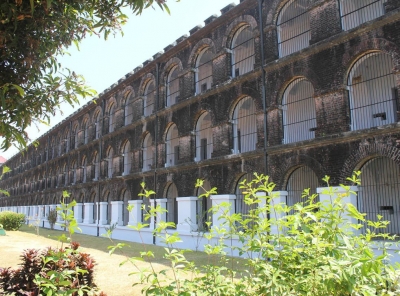
Cellular Jail in Andaman and Nicobar Islands, India, stands as a dark reminiscence of the British rule in the Indian subcontinent. This most dreaded and gruelling colonial prison situated in the remote archipelago was used by the British particularly to exile Indian political prisoners. Isolated from the mainland, this jail, also referred as Kala Pani (where Kala means death or time and Pani means water in Sanskrit) witnessed the most atrocious punishments imposed on prisoners. India’s struggle for independence saw imminent freedom fighters like Batukeshwar Dutt and Veer Savarkar being incarcerated in this jail. The jail is now open to public viewing as a National Memorial, and its museum gives one a glimpse of years of India’s struggle for freedom.
The building of the Cellular Jail originally had seven straight wings each connected to a tower in the middle giving the whole construction a look of something like a bicycle wheel with each wing attached with the centre tower like a spoke of the wheel. This design was based on English philosopher and social theorist Jeremy Bentham’s concept of the Panopticon. Puce coloured bricks were brought from Burma to construct the building. The tower in the centre that formed the point of intersection of all the seven wings served as a watch point for the guards of the jail to keep vigil on prisoners. It had a large bell for raising alarm. The wings, each of which had three storeys, were constructed in such manner that the front of one wing faces the back of another so that one inmate in a wing cannot see or communicate with another inmate in any of the adjacent wings. Even the cells in a wing were in a row so that inmates in the same wing also cannot communicate or see each other. Each cell housed only one prisoner ensuring minimal chance of communication among inmates thus isolating them from each other. This feature of solitary confinement in individual cells earned the jail its name, “Cellular”. There were a total of 693 cells, each measuring 4.5 m by 2.7 m with a ventilator located at a height of 3 m. There were no dormitories in the jail.
Credit : Cultural India
Picture Credit : Google




